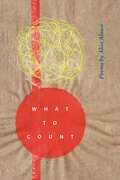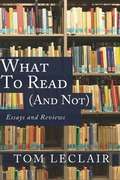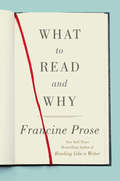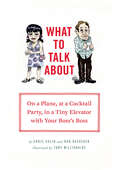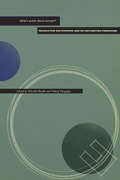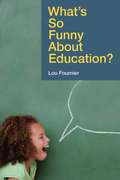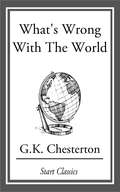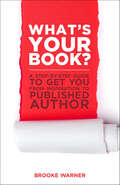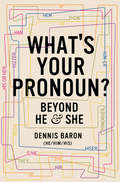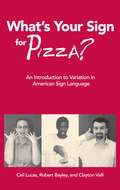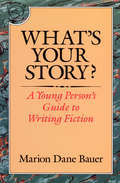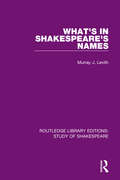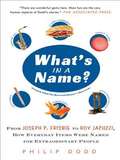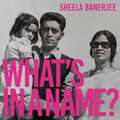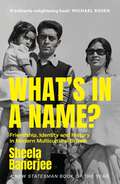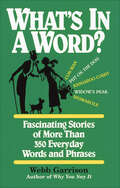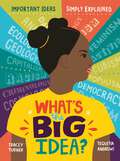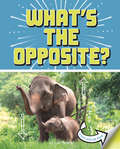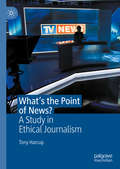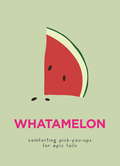- Table View
- List View
What to Count (Made in Michigan Writers Series)
by Alise AlousiWith heart and insight, the poems in Alise Alousi’s What to Count speak to what it means to come of age as an Iraqi American during the first Gulf War and its continuing aftermath, but also to the joy and complexity of motherhood, daughterhood, and what it means to live a creative life. More than a description of the world, Alousi’s poetry actively lives in and of the world. These poems explore the nuances of memory through the changes wrought by time, conflict, and distance. In "The Ocularist" and "Art," and others, Alousi’s extraordinary verbal deftness precisely locates the still-tender pains and triumphs of collective being while trying to be an individual in the world. What to Count is a remarkable collection of contemporary poetry—both a lyrical splendor and a contemplative account of lineage, silenced history, and identity.
What to Read (and Not)
by Tom LeclairThese essays and reviews are mostly about literary fiction published in the last ten years and are written from the perspective of a fan of the McElroy/Coover/DeLillo axis or, more recently, the Powers/Vollmann/Wallace axis. The review-essays include pieces on all of the National Book Award fiction finalists of the last five years. Reviews selected here first appeared in Electronic Book Review, Barnes and Noble Review, New York Times Book Review, Atlantic, BookForum, The Nation, American Book Review, Daily Beast, and other national periodicals. Taken together, the essays and reviews comment on the state of literary culture--the fiction division--in America. Also included are several personal essays about the development of the author from a Vermont woodsman to a Brooklyn wordsman.
What to Read Next: How to Make Books Part of Your Life
by Stig AbellAn audiobook to help make books part of your life.For a whole year on his train to work, Stig Abell read books from across genres and time periods. Then he wrote about them, and their impact on our culture and his own life.The result is a work of many things: a brisk guide to the canon of Western literature; an intimate engagement with writers from Shakespeare to JK Rowling, Marcel Proust to Zora Neale Hurston; a wise and funny celebration of the power of words; and a meditation on mental unrest and how to tackle it. It will help you discover new books to love, give you the confidence to give up on those that you don't, and remind you of ones that you already do.What to Read Next: How to Make Books Part of Your Life has been written for the reader in all of us.(P) 2020 Hodder & Stoughton Ltd
What to Read and Why
by Francine ProseIn this brilliant collection, the follow-up to her New York Times bestseller Reading Like a Writer, the distinguished novelist, literary critic, and essayist celebrates the pleasures of reading and pays homage to the works and writers she admires above all others, from Jane Austen and Charles Dickens to Jennifer Egan and Roberto Bolaño.In an age defined by hyper-connectivity and constant stimulation, Francine Prose makes a compelling case for the solitary act of reading and the great enjoyment it brings. Inspiring and illuminating, What to Read and Why includes selections culled from Prose’s previous essays, reviews, and introductions, combined with new, never-before-published pieces that focus on her favorite works of fiction and nonfiction, on works by masters of the short story, and even on books by photographers like Diane Arbus.Prose considers why the works of literary masters such as Mary Shelley, Charles Dickens, George Eliot, and Jane Austen have endured, and shares intriguing insights about modern authors whose words stimulate our minds and enlarge our lives, including Roberto Bolaño, Karl Ove Knausgaard, Jennifer Egan, and Mohsin Hamid. Prose implores us to read Mavis Gallant for her marvelously rich and compact sentences, and her meticulously rendered characters who reveal our flawed and complex human nature; Edward St. Aubyn for his elegance and sophisticated humor; and Mark Strand for his gift for depicting unlikely transformations. Here, too, are original pieces in which Prose explores the craft of writing: "On Clarity" and "What Makes a Short Story."Written with her sharp critical analysis, wit, and enthusiasm, What to Read and Why is a celebration of literature that will give readers a new appreciation for the power and beauty of the written word.
What to Talk About: On a Plane, at a Cocktail Party, in a Tiny Elevator with Your Boss's Boss
by Rob Baedeker Chris Colin Tony MillionaireHomo sapiens have been speaking for hundreds of years--and yet basic communication still stymies us. We freeze up in elevators, on dates, at parties, under Dumpsters. We stagger through our exchanges merely hoping not to crash, never considering that we might soar. We go home sweaty and eat a birthday cake in the shower.But no more. With What to Talk About you'll learn to speak--fluently, intelligently, charmingly--to family, friends, coworkers, lovers, future lovers, horse trainers, children, even yourself. This hilarious manual, written by two award-winning authors and illustrated by legendary cartoonist Tony Millionaire, is tailor-made for anyone who might one day attend a dinner party, start a job, celebrate a birthday, graduate from school, date a human, or otherwise use words.What to Talk About is not rocket science, but it is a lot like brain surgery, in the sense that is terrifying, risky--and could change you forever.
What's Blowing In? (Reach Into Phonics Ser.)
by Deborah J. Short Debbie O'Brien Winston WhiteNIMAC-sourced textbook
What's Queer about Europe?: Productive Encounters and Re-enchanting Paradigms
by Mireille Rosello Sudeep DasguptaWhat’s Queer about Europe? examines how queer theory helps us initiate disorienting conjunctions and counterintuitive encounters for imagining historical and contemporary Europe. This book queers Europe and Europeanizes queer, forcing a reconsideration of both. Its contributors study Europe relationally, asking not so much what Europe is but what we do when we attempt to define it.The topics discussed include: gay marriage in Renaissance Rome, Russian anarchism and gender politics in early-twentieth-century Switzerland, colonialism and sexuality in Italy, queer masculinities in European popular culture, queer national identities in French cinema, and gender theories and activism. What these apparently disparate topics have in common is the urgency of the political, legal, and cultural issues they tackle. Asking what is queer about Europe means probing the blind spots that continue to structure the long and discrepant process of Europeanization.
What's So Funny About Education? (1-off Ser.)
by Lou FournierUsing affectionate humor, Fournier delivers both stark and subtle epiphanies alongside enduring truths, offering a deeper social commentary on the present conditions and future directions of American education.With an engaging satirical approach, the author spares no topic in casting a wide net over education, covering music and the arts, school culture, leadership, assessment, staff development, history, technology, higher education, and many more.
What's Wrong with the World
by G. K. ChestertonIn the aptly titled treatise What's Wrong With the World, one of the twentieth century's most memorable and prolific writers takes on education, government, big business, feminism, and a host of other topics. A steadfast champion of the working man, family, and faith, Chesterton eloquently opposed materialism, snobbery, hypocrisy, and any adversary of freedom and simplicity in modern society. Culled from the thousands of essays he contributed to newspapers and periodicals over his lifetime, the critical works collected for this edition pulse with the author's unique brand of clever commentary. As readable and rewarding today as when they were written over a century ago, these pieces offer Chesterton's unparalleled analysis of contemporary ideals, his incisive critique of modern efficiency, and his humorous but heartfelt defense of the common man against trendsetting social assaults.
What's Your Book?: A Step-by-Step Guide to Get You from Inspiration to Published Author
by Brooke WarnerWhat's Your Book? is an aspiring author’s go-to guide for getting from idea to publication. Brooke Warner is a publishing expert with thirteen years’ experience as an acquiring editor for major trade houses. In her book, she brings her unique understanding of book publishing (from the vantage point of coach, editor, and publisher) to each of the book's five chapters, which include understanding the art of becoming an author, getting over common hurdles, challenging counterproductive mindsets, building an author platform, and ultimately getting published. Brooke is known for her straightforward delivery, honest assessments, and compassionate touch with authors. What's Your Book? contains the inspiration and information every writer needs to publish their first or next book.
What's Your Pronoun?: Beyond He And She
by Dennis BaronAddressing one of the most pressing cultural questions of our generation, Dennis Baron reveals the untold story of how we got from he and she to zie and hir and singular-they. Like trigger warnings and gender-neutral bathrooms, pronouns are sparking a national debate, prompting new policies in schools, workplaces, even prisons, about what pronouns to use. Colleges ask students to declare their pronouns along with their majors; corporate conferences print name tags with space to add pronouns; email signatures sport pronouns along with names and titles. Far more than a by-product of the culture wars, gender-neutral pronouns are, however, nothing new. Pioneering linguist Dennis Baron puts them in historical context, noting that Shakespeare used singular-they; women invoked the generic use of he to assert the right to vote (while those opposed to women’s rights invoked the same word to assert that he did not include she); and people have been coining new gender pronouns, not just hir and zie, for centuries. Based on Baron’s own empirical research, What’s Your Pronoun? chronicles the story of the role pronouns have played—and continue to play—in establishing both our rights and our identities. It is an essential work in understanding how twenty-first-century culture has evolved.
What's Your Sign for Pizza?: An Introduction to Variation in American Sign Language
by Ceil Lucas Robert Bayley Clayton ValliThis introductory text celebrates another dimension of diversity in the United States Deaf community — variation in the way American Sign Language (ASL) is used by Deaf people all across the nation. The different ways people have of saying or signing the same thing defines variation in language. In spoken English, some people say “soda,” others say “pop,” “Coke,” or “soft drink;” in ASL, there are many signs for “birthday,” “Halloween,” “early,” and of course, “pizza.” What’s Your Sign for Pizza? derives from an extensive seven-year research project in which more than 200 Deaf ASL users representing different ages, genders, and ethnic groups from seven different regions were filmed sharing their signs for everyday vocabulary. The film clips form a supplemental resource to the text and are referenced in their relevant chapters. The text begins with an explanation of the basic concepts of language and the structure of sign language. Each part of the text concludes with questions for discussion, and the final section offers three supplemental readings that provide further information on variation in both spoken and signed languages. What’s Your Sign for Pizza also briefly sketches the development of ASL, which explains the relationships between language varieties throughout the country. The videos are available online at www.youtube.com/GallaudetUniversityPress.
What's Your Story?: A Young Person's Guide to Writing Fiction
by Marion Dane BauerThe award-winning author &“provides mentoring and practical and technical advice in this handy how-to book . . . as useful to teachers as to young writers&” (School Library Journal, starred review). Storytelling is a universal experience. From an early age, we begin to shape our own world by crafting tales. But learning to tell—and write—a good story isn&’t easy. It takes dedication and practice, just like for a musician or an athlete, and it can be just as rewarding to accomplish as winning a game or mastering an instrument. It&’s the kind of work that feeds our souls and makes us glad to be alive. In What&’s Your Story?, Newbery Medal-winning author Marion Dane Bauer discusses how to write fiction from beginning to end, including creating a story plan, choosing the best idea, bringing characters to life, deciding on a point of view, creating realistic dialogue, keeping readers hooked, and revising and polishing the finished product. &“Her last comment is telling: &‘Knowing your craft can help you tell a story. But only by taking risks can you make art.&’ After many pages of provocative information and straightforward counsel, that sentence may be the one to launch youngsters to the challenge. The book speaks directly to young writers, but many adults (teachers, librarians, reviewers, editors, would-be writers) will also find this sensible dissection of the storytelling process invaluable.&”—Kirkus Reviews (starred review) &“A pragmatic, organized approach to story writing . . . the exercises and thought processes introduced as groundwork come across as stimulating rather than tedious and may serve to hone analytical skills as well as inspire even the most reluctant writers to try their hand.&”—Publishers Weekly
What's a Pair? What's a Dozen?
by Stephen R. SwinburneThe world is filled with numbers. From learning to count their fingers to learning to put on their shoes, children encounter mathematical concepts early in life. Steve Swinburne introduces children to number-related words in this bouncy, colorful photo-essay. From one to a dozen, lively photographs illustrated math words such as single, double, couple, and prefixes such as uni-, bi-, and tri-. The second half of the book is presented as a guessing game. Following Lots and Lots of Zebra Stripes and Guess Whose Shadow?, Steve Swinburne offers children another entertaining look at an all-important concept.
What's in Shakespeare's Names (Routledge Library Editions: Study of Shakespeare)
by Murray J. Levith‘What’s in a name? That which we call a rose/By any other name would smell as sweet.’ So says Juliet in the balcony scene from Romeo and Juliet but, originally published in 1978, Murray Levith shows just how wrong Juliet was. Shakespeare was extremely careful in his selection of names. Not only the obvious Hotspur or the descriptive Bottom or Snout, but most names in Shakespeare’s thirty-seven plays had a more than superficial significance. Beginning with what has been written previously, Levith illustrates how Shakespeare used names – not only those he invented in the later comedies, but those names bequeathed to him by history, myth, classical literature, or the Bible. Levith moves from the histories through the tragedies to the comedies, listing each significant name play by play, giving the allusions, references, and suggestions that show how each name enriches interpretations of action, character, and tone. Dr. Levith examines Shakespeare’s own name, and speculates upon the playwright’s identification with his characters and the often whimsical naming games he played or that were played upon him. A separate alphabetical index is provided to facilitate the location of individual names and, in addition, cross references to plays are given so that each name can be considered in the context of all the plays in which it appears.
What's in a Name?
by Philip DoddA brilliant and personal literary journey, in which Philip Dodd tells the curious tales of people whose names?deliberately or by chance?became household words What?s in a name? For Philip Dodd, this question led to an international tour, sleuthing the history of some of our most intriguing eponyms. The result is a collection of surprising, stranger-than-fiction stories from history, the arts, the halls of science, and sometimes simply the realm of serendipity. This armchair traveler?s delight contains little-known tales of such immortal figures as: · Roy Jacuzzi, alive and well and still bubbling with ideas in Happy Valley, California · Joseph P. Frisbie, the baker whose pie tins inspired Wham-O?s ubiquitous flying disc · Ernst Gräfenberg, for whom the G-spot was named ? Samuel Maverick, the Texas pioneer who refused to brand his calves · And many other colorful figures From Belgium to Buenos Aires, from Orlando to Los Angeles, Dodd?s readers go along for the ride. What?s In a Name? is a marvelous tribute to people who changed our language?whether through hard work, creativity, or the luck of the draw. .
What's in a Name?
by Philip DoddA brilliant and personal literary journey, in which Philip Dodd tells the curious tales of people whose names?deliberately or by chance?became household words What?s in a name? For Philip Dodd, this question led to an international tour, sleuthing the history of some of our most intriguing eponyms. The result is a collection of surprising, stranger-than-fiction stories from history, the arts, the halls of science, and sometimes simply the realm of serendipity. This armchair traveler?s delight contains little-known tales of such immortal figures as: · Roy Jacuzzi, alive and well and still bubbling with ideas in Happy Valley, California · Joseph P. Frisbie, the baker whose pie tins inspired Wham-O?s ubiquitous flying disc · Ernst Gräfenberg, for whom the G-spot was named ? Samuel Maverick, the Texas pioneer who refused to brand his calves · And many other colorful figures From Belgium to Buenos Aires, from Orlando to Los Angeles, Dodd?s readers go along for the ride. What?s In a Name? is a marvelous tribute to people who changed our language?whether through hard work, creativity, or the luck of the draw.
What's in a Name?: Friendship, Identity and History in Modern Multicultural Britain
by Sheela BanerjeeA sharp and timely examination of Britain's history, through the prism of something intimate and everyday - everyone's name tells a story, no matter how ordinary'Our names reveal a multitude of stories, reveal feelings, states of consciousness and lost histories that embody who we really are and where we come from . . . This is a personal journey to reveal the worlds which gave rise to what we are called'Our names are so mundane that we barely notice them. Yet each contains countless stories of tradition and belonging - be that a legacy of colonialism or persecution, the desire to fit in, or the complex cultural inheritance from one's parents. In What's in a Name?, Sheela Banerjee unravels the personal histories of friends and family through their names. And while tracing their heritage across centuries and continents - from west London to British India, and from 1960s Jamaica to pre-Revolutionary Russia - Sheela also tells the story of twentieth-century immigration to the UK.Blending history, memoir and politics, What's in a Name? is a celebration of Britain's rich multiculturalism, an ode to friendship and a testament to all the stories held within our names.(P)2023 Hodder & Stoughton Limited
What's in a Name?: Friendship, Identity and History in Modern Multicultural Britain
by Sheela Banerjee'A brilliantly enlightening book . . . at times moving, at others ironic, full of insights and detail' Michael RosenOur names are so mundane that we barely notice them. Yet each contains countless stories of tradition and belonging - be that a legacy of colonialism or persecution, the desire to fit in, or the complex cultural inheritance from one's parents. In What's in a Name?, Sheela Banerjee unravels the personal histories of friends and family through their names. And while tracing their heritage across centuries and continents - from west London to British India, and from 1960s Jamaica to pre-Revolutionary Russia - Sheela also tells the story of twentieth-century immigration to the UK.Blending history, memoir and politics, What's in a Name? is a celebration of Britain's rich multiculturalism, an ode to friendship and a testament to all the stories held within our names.
What's in a Word?: Fascinating Stories of More Than 350 Everyday Words and Phrases
by Webb GarrisonA compendium containing the origins and history of some of the most common words and phrases in the English language.Once upon a time . . . Tying the knot actually involved tying a knot—not saying vows. Meanwhile, a thinking cap wasn’t just a cute idea for schoolchildren, but an actual hat worn by scholars in the Middle Ages. Oh, and when you make no bones about something, you should consider yourself lucky you aren’t choking on a chicken foot. What’s in a Word? answers the question it poses, more than three hundred times over. You’ll learn which side of the bed is the wrong side, and why the word “nickname” is simply the product of slurred speech. Webb Garrison’s etymological journey through the origins of words and phrases, both common and obscure, is sure to fascinate wordsmiths of every stripe.
What's the Big Idea?
by Tracey TurnerHave you ever wondered what capitalism is? How about feminism, ecology, epidemiology or astronomy? Well, this book will give you straightforward, easy-to-understand answers to all your troublesome-word questions WITHOUT going on and on for ages OR using even BIGGER words to explain them. Informative, bite-sized explanations alongside beautiful, eye-catching illustrations will help readers aged 8+ understand crucial concepts, giving them the power to take part in the most important conversations on the planet. Perfect for inquisitive minds, this book will appeal to fans of Goodnight Stories for Rebel Girls, Big Ideas for Curious Minds and beyond.More than 100 big words and ideas, simply explained.
What's the Import?: Nineteenth-Century Poems and Contemporary Critical Practice
by Kerry McSweeneyKerry McSweeney critiques such readings of Romantic, Victorian, and 19th-century American poems. In What's the Import? he proposes and exemplifies an aesthetic or intrinsic critical model rooted in literary-historical contextualization that considers the determination of meanings to be only one of the qualities that full engagement with a poem requires. His wide-ranging study discusses poems by Wordsworth, Keats, Tennyson, Browning, Whitman, Dickinson, Carroll, Dante and Christina Rossetti, Swinburne, Hopkins, Hardy, and the Michael Field poets. What's the Import? contributes to the current debates in North America about the state and direction of English studies and the teaching of literature in general.
What's the Opposite?: A Turn-and-See Book (What's Next?)
by Cari MeisterWah! Wah! A crying baby is loud. But what about a sleeping baby? You guessed it! A sleeping baby is quiet. With a flip of the page you will discover that opposites are everywhere.
What's the Point of News?: A Study in Ethical Journalism
by Tony HarcupThis book questions whether the news we get is as useful for citizens as it could, or should, be. This international study of news is based on re-thinking and re-conceptualising the news values that underpin understandings of journalism. It goes beyond empirical descriptions of what journalism is to explore normative ideas of what it might become if practised alongside commitments to ethical listening, active citizenship and social justice. It draws lessons from both alternative and mainstream media output; from both journalists and scholars; from both practice and theory. It challenges dominant news values by drawing on insights from feminism, peace journalism and other forms of critical thinking that are usually found on the margins of journalism studies. This original and engaging contribution to knowledge proposes an alternative set of contemporary news values that have significant implications for the news industry, for journalism education and for democracy itself.
WhatAMelon: Comforting pick-you-ups for epic fails
by PyramidIf you know a pearfect numpty who needs a bit of sage advice, chia them up with this little book of upbeat and adorkable fruit puns.#youokalehun?About the seriesThis cute and colourful series of fruit-pun-filled gift books are the perfect pick-me-ups for you, your friend or your partner in crime. Do you need to avocuddle, or are you grapeful for someone who's a bit of a melon? Then share the clove with these little books: AvoCuddle, WhataMelon, You are my Raisin for Living, Don't Give a Fig, I am Grapeful, You are 24 Carrot Gold.*veg, nuts and seeds are fair game
